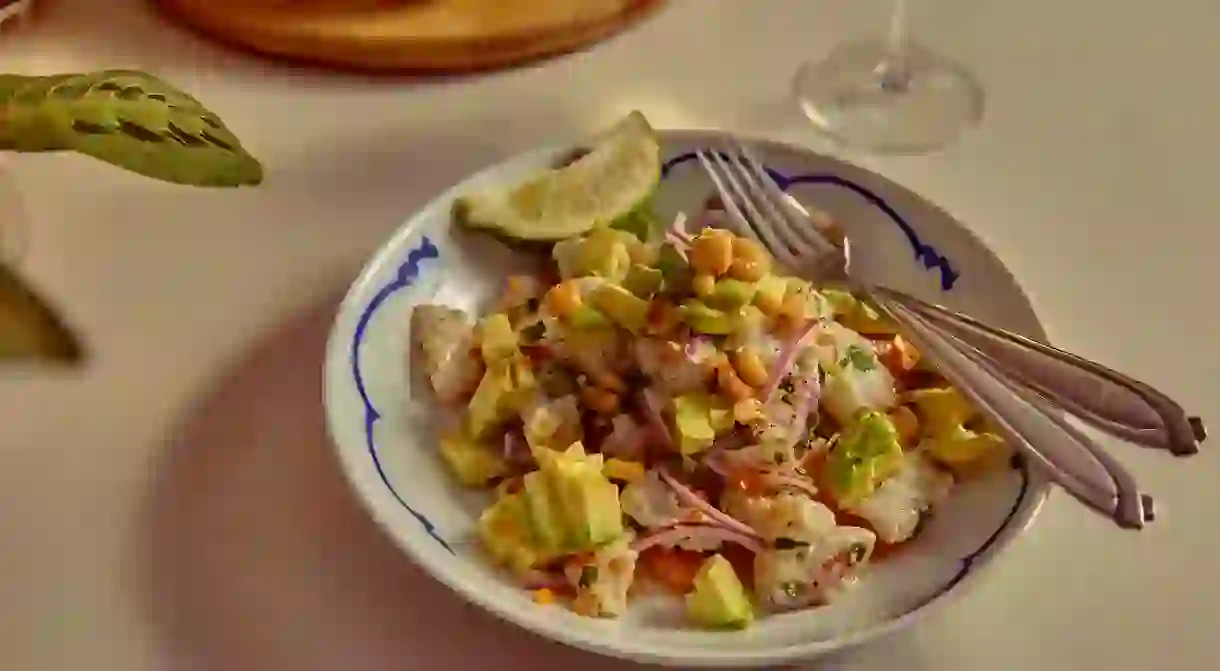How to Make Authentic Peruvian Ceviche According to a Local Cordon Bleu Chef

Ceviche, a lunchtime treat of lime and chili-marinated fish, is the dish that helped Peru earn its reputation as South America’s culinary capital, and is the undisputed star of Peruvian cuisine. We stopped by TASTE Peruvian Cooking Studio to chat to Lima-born Cordon Bleu chef, Christian Manrique, to learn the secrets behind making this delicious Peruvian classic.
Where do you think the love for ceviche comes from in Peru?
Ceviche has been our flagship dish since day one, and we are very proud of it as a country. But it’s more than that; it’s part of our identity. As many of the ingredients needed for an authentic tasting ceviche can only be found in Peru, it’s a dish that is truly ours; it represents our country’s unique flavors, smells, colors, and even our way of life.

Before we start cooking, what, for you, makes an authentic Peruvian ceviche?
Ceviche is all about top quality, fresh ingredients. For example, when choosing your fish, it is essential to choose a very fresh, firm-fleshed white fish, such as sole, sea bass, rockfish or grouper. The Limo chili too, as well as our highly acidic limes, strong garlic, and fresh cilantro and ginger, are also key for achieving the authentic Peruvian ceviche flavor. You could replace these ingredients with habanero chilies and key limes, but, again, it’s the Peruvian ingredients that really make this dish shine.

What are the common mistakes you see when newbies take on Peru’s national dish?
A common mistake with ceviche is not following the correct order. It may seem silly, but the way we put our ceviche together makes all the difference. Peruvians always season the fish first (so that it absorbs all the flavors), then mix all the ingredients in and, as the very last step, squeeze in the lime juice (but not too hard otherwise this will release the bitter oils of the lime). It is also important not to cut the fish too small (the fish should be cut into cubes of 1.5 centimeters [0.6 inches] so that it doesn’t ‘overcook’ in the lime juice).
Any final tips before we take the plunge?
Try to handle the fish as little as possible and always keep your ingredients nice and cold. Oh, and serve immediately! Ceviche is like a salad, it tastes best when it’s fresh out the kitchen.
.

What you’ll need
Now that you’ve got the low-down on Peru’s national dish, it’s time to get down to business. According to Chef Manrique, here’s what you’ll need for a knockout ceviche.

For the ceviche
1 fresh white fish fillet
½ tsp garlic paste
½ grated ginger
1 whole bunch of cilantro, roughly chopped
1 Limo chili, deveined and finely diced
½ red onion
4 Peruvian limes
Salt
Pepper
To serve
1 avocado
Chushuro (Known as the “caviar” of Peru, chushuro is blue-green algae found in lagoons and wetlands over 3,600 meters [11,800 feet]. If you’re in Peru, you can find these in food markets in Cusco, Lima, Huaraz, and Huancayo. If not, then don’t worry, this is an optional serving ingredient).
Roasted cancha (Cornuts)
Caramelized sweet potatoes
Method
1. Cut the fish into 1 x 1-inch chunks and place into a bowl.
2. Season the fish chunks with salt and pepper, and then add your garlic and ginger paste. Mix well.

3. Add the roughly chopped cilantro, deveined chili, and thinly sliced red onion.
4. Mix all the ingredients together, while gently squeezing in the lime juice. Make sure here that you’re constantly tossing the ingredients in order to release what Peruvians know as leche de tigre, the flavorsome, citrusy and spicy milk-white ceviche juices.
5. Taste and adjust seasoning, bearing in mind that a good ceviche has the perfect balance between acidity and saltiness. Put aside.

How should I serve it?
How you serve your ceviche can be just as important as the ceviche itself. While every chef puts their own spin on it (Chef Manrique, for example, loves to add chunks of avocado and a sprinkling of Chuschuro to give the dish “another layer of texture and depth”), there are two very important accompaniments to Peru’s national dish: sweet potato and toasted corn. Here’s how to do it:

1. Peel and cut your sweet potato into thick circles. Place them in a large saucepan with a spoonful of honey and bring it to a boil. Lower the heat and simmer for a further 4-6 minutes until your potato is soft and golden, and all the liquid has disappeared. Once cooked and cooled, place 3-4 slices of the caramelized potato at the bottom of a deep plate and top with a generous spoonful of the ceviche you made earlier.
2. Toast your ‘cancha’ corn nuts over a medium heat with a little oil and generous sprinkling of salt.
3. Finally, garnish your ceviche and sweet potato dish with your freshly toasted corn nuts and, for that extra bit of depth, avocado dices and Chushuro (optional).
It’s a good idea to make the accompaniments before making the ceviche, that way you can serve it up immediately.

Meet the chef
Christian Manrique is a Peruvian chef who trained at the prestigious Le Cordon Bleu Culinary Arts School. After working in top-end restaurants and five-star hotels in Sydney and Miami, he returned to Peru to set up his own cooking school in Cusco, where, through combining Andean ingredients with contemporary cooking techniques, he aims to showcase his country’s diverse culinary roots to the world.













